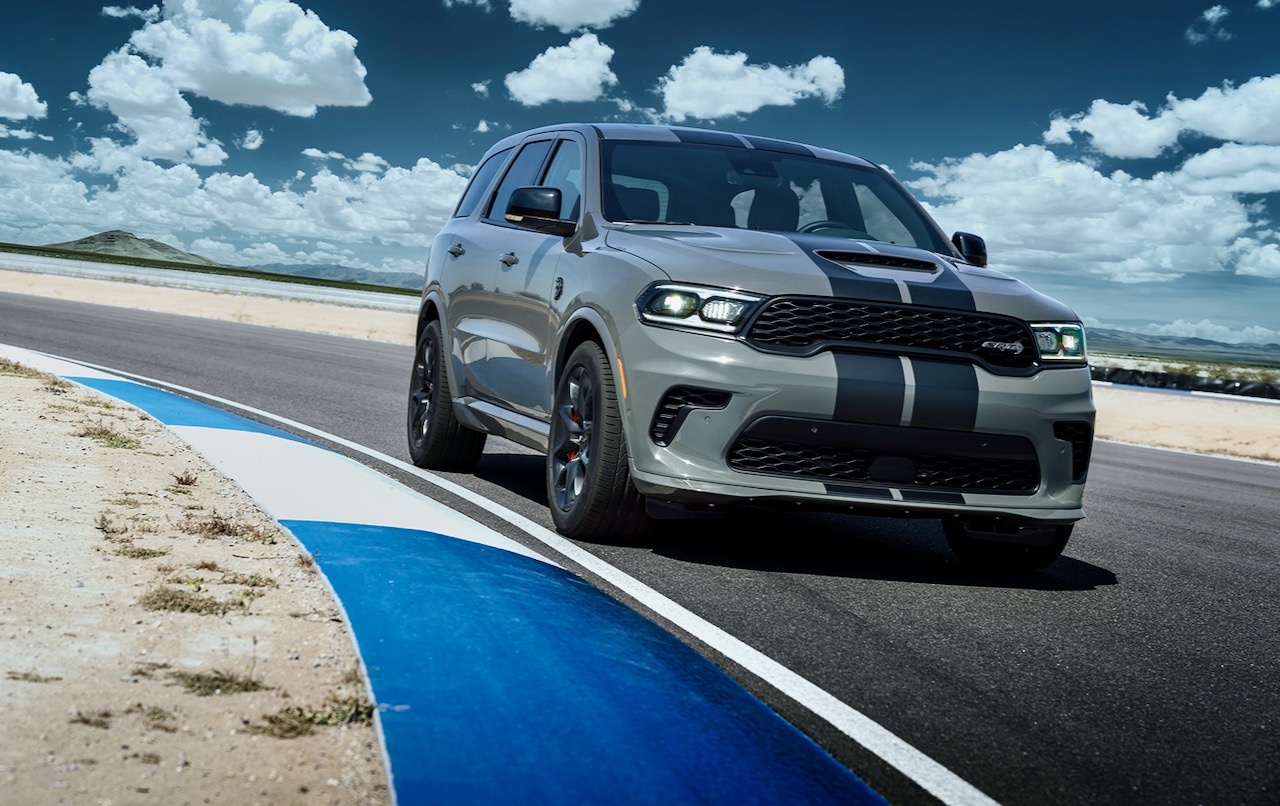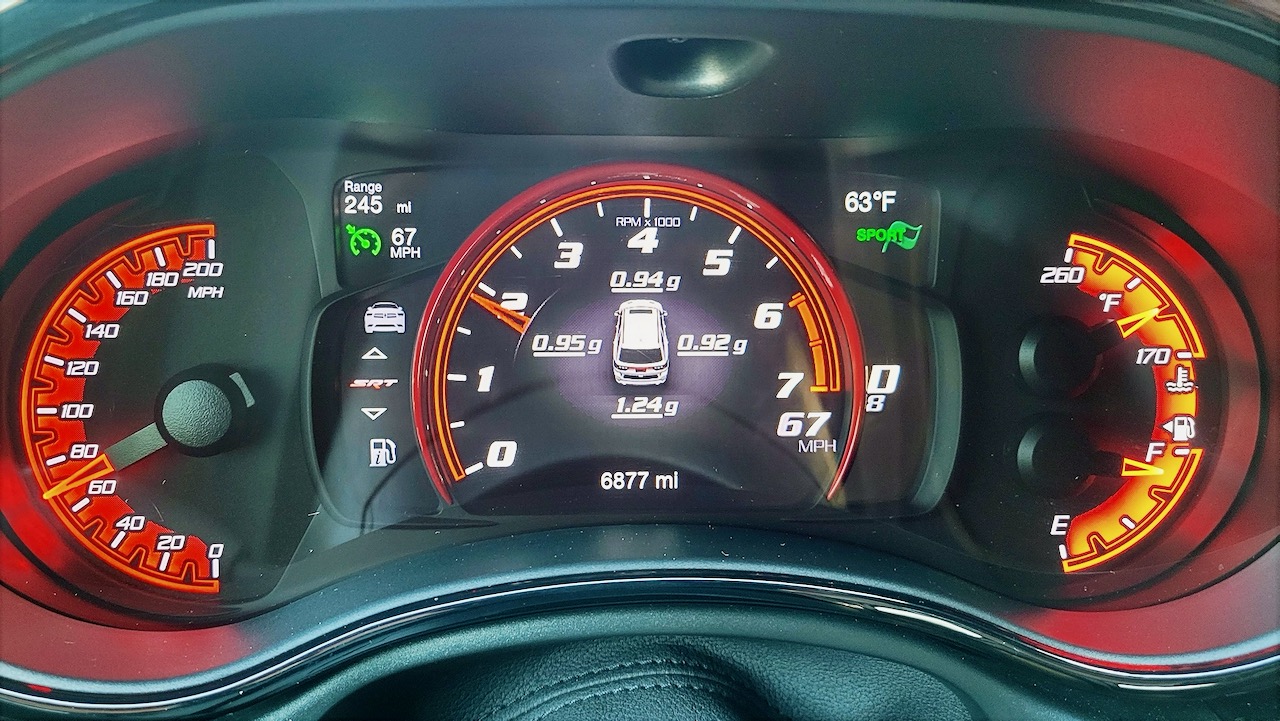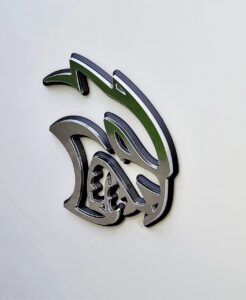With 710 Hemi horsepower, room for six, and Supercar acceleration, Dodge’s latest Sport Utility Vehicle – DURANGO SRT HELLCAT: ONE HELLUVA SUV – has no peers, blogs Dan Scanlan.
Yes, the Durango has been around for 10 years, making it pretty long-in-tooth in automotive model cycles. And the fine folks at what is now Stellantis have put its supercharged HEMI in many other products including Chargers, Challengers and the Jeep Grand Cherokee Trackhawk. Packing a supercharged 6.2-liter HEMI Hellcat V-8, rated at 710 horsepower and 645 foot-pounds of torque, makes our Durango tester the most powerful SUV made.
And it looks the part under that scooped and vented hood. There’s a massive ribbed supercharger with integrated electronic bypass valve regulating boost pressure to a maximum of 11.6 psi. Its HEMI-orange painted cast-iron engine block sports a forged-steel crankshaft with tuned damper, forged-alloy pistons; powder-forged connecting rods with high-load-capacity bushings and carbon-coated piston pins and a 260-millimeter crossover X-pipe, largest in the SRT lineup, ending twin-pipe exhaust.
 The Hellcat barks to life, then a bassy idle that becomes a scream as soon as gas pedal is pushed and supercharger engages. The amount it engages can be fine-tuned via multiple drive modes: Auto (with Eco), Street, Sport and Track, as well as Custom to set engine, transmission, steering and suspension feel. And if you must use the Durango as an SUV, there’s Snow, Tow and lower-power Valet settings.
The Hellcat barks to life, then a bassy idle that becomes a scream as soon as gas pedal is pushed and supercharger engages. The amount it engages can be fine-tuned via multiple drive modes: Auto (with Eco), Street, Sport and Track, as well as Custom to set engine, transmission, steering and suspension feel. And if you must use the Durango as an SUV, there’s Snow, Tow and lower-power Valet settings.
Eco dumbs down the throttle so you can drive this Hellcat gently, with smooth, metered gearshifts and just enough power without too much supercharger scream or acceleration. That’s for passengers in the cheap seats, OK for daily commuting and not slow at all – 60 mph in Eco only took 4.5 seconds. It helped us average almost 14 mpg on highway runs, more than enough power pass without a downshift.
But what’s a Hellcat without its scream? Set in Sport, which tightens up shifting and steering feel and gives you all the engine with traction/stability control armed, it leaped off the line to hit 60 in 3.5 seconds. But the E-ticket ride is using Launch Control. Set optimum launch rpm, hold the brake, then bury the gas pedal. In a second, the gauge display says “go-for-it”, and you release the brake. With a very rearward 30/70 torque split, the rear Pirellis gave us a controlled 6-foot-long burnout as we hit 60 mph in 3.36 seconds, and 100 in 8.7 – almost the fastest vehicle I’ve tested this year. Launch Assist is in use here as well, using wheel speed sensors to dampen wheel hop for full grip and managed tire slip for straight all-wheel-drive acceleration. We pulled 1.09Gs at full thrust. In Track mode, add exhaust “whoomps” on each sharp upshift, and overrun crackle and throttle blips on downshifts.
 Despite being a 5,710-pound SUV that can tow up to 8,700 pounds, our almost-9,000-mile-old Durango really handles. Dodge claims it reduced understeer by 2.5 percent, so a driver can go into a corner faster and exit quicker. In sweeping curves, the Durango Hellcat had a bit of body roll as the 20-inch Pirelli Scorpions grabbed. Then it just carved the corner. We could just power through a curve, the rearward-biased all-wheel-drive allowing the tail out a bit on turns in Sport mode, easily catchable as power spread forward. The onboard G-force meters showed almost 1G in cornering. And as our video shows, it just goes through turns time after time with no drama, handling predictably, a very involving and communicative SUV that looked forward to curves.
Despite being a 5,710-pound SUV that can tow up to 8,700 pounds, our almost-9,000-mile-old Durango really handles. Dodge claims it reduced understeer by 2.5 percent, so a driver can go into a corner faster and exit quicker. In sweeping curves, the Durango Hellcat had a bit of body roll as the 20-inch Pirelli Scorpions grabbed. Then it just carved the corner. We could just power through a curve, the rearward-biased all-wheel-drive allowing the tail out a bit on turns in Sport mode, easily catchable as power spread forward. The onboard G-force meters showed almost 1G in cornering. And as our video shows, it just goes through turns time after time with no drama, handling predictably, a very involving and communicative SUV that looked forward to curves.
 As far as looks, 2021’s Durango gets a slimmer black mask grill with LED-rimmed projector beam headlights framed by DRLs, more aggressive forward-swept mesh grill over bumper, plus deep lower intake with serious chin spoiler and functional side intakes. Fog lamps get replaced by a cold-air scoop in the lower fascia to feed supercharger and Hellcat’s 92-mm throttle body. It gains a power bulge hood with center scoop and dual vents, while those Pirellis live on brushed alloy and pewter 10-spoke alloy wheels, tread peeking out from shouldered and flared fenders. Huge red Brembo calipers are visible inside spokes. There’s a new rear spoiler/sunshade that creates real downforce of 140 pounds at 180 mph, SRT says.
As far as looks, 2021’s Durango gets a slimmer black mask grill with LED-rimmed projector beam headlights framed by DRLs, more aggressive forward-swept mesh grill over bumper, plus deep lower intake with serious chin spoiler and functional side intakes. Fog lamps get replaced by a cold-air scoop in the lower fascia to feed supercharger and Hellcat’s 92-mm throttle body. It gains a power bulge hood with center scoop and dual vents, while those Pirellis live on brushed alloy and pewter 10-spoke alloy wheels, tread peeking out from shouldered and flared fenders. Huge red Brembo calipers are visible inside spokes. There’s a new rear spoiler/sunshade that creates real downforce of 140 pounds at 180 mph, SRT says.
 Inside, like the latest Chargers and Challengers, is an updated, clean, well-designed and built interior in black over red, complimented by hand-stitched leatherette covering flowing dashboard cowl and doors. Driver and passenger get heavily-bolstered Nappa leather sports buckets with embossed Hellcat logos, plus heat, cooling and multiple power adjustments. The flat-bottom steering wheel’s fat stitched leather rim gets a red-lit SRT badge, small alloy paddle shifters integrated with stereo controls in back.
Inside, like the latest Chargers and Challengers, is an updated, clean, well-designed and built interior in black over red, complimented by hand-stitched leatherette covering flowing dashboard cowl and doors. Driver and passenger get heavily-bolstered Nappa leather sports buckets with embossed Hellcat logos, plus heat, cooling and multiple power adjustments. The flat-bottom steering wheel’s fat stitched leather rim gets a red-lit SRT badge, small alloy paddle shifters integrated with stereo controls in back.
The SRT-specific gauge package gets bright red-lit 200-mph speedometer and gas/engine temp gauges with floating needles. In the middle, a digital 7,000-rpm tach framing a central display inside for audio, navigation turn-by-turn info, multiple trip computer and mileage screens and engine gauges. Or set a digital speed readout, instant G-force, drag strip times and other performance info.
 A new 10.1-inch main touchscreen handles navigation, a good 825-watt/19-speaker Harman Kardon audio system and performance pages to get engine gauges, G-force, power and torque, acceleration times and more. There are physical controls now for a/c, drive modes and launch control on smoked chrome buttons, vs. having to dive into layers of touchscreens as in year’s past. There’s a new user-friendly climate control too, plus a big inductive cellphone charger pad in the redesigned console near four USB ports and an MP3 input. Uconnect has Wi-Fi, wireless Apple CarPlay and Android Auto. Back doors open on two leather-clad reclining bucket seats that don’t slide, so there’s just enough leg room for adults, while that longer wheelbase means the third row had adequate adult head and leg room. Fold second and third row seatbacks for a big 85.1-cu-ft. The power hatch opens high, but not hands-free.
A new 10.1-inch main touchscreen handles navigation, a good 825-watt/19-speaker Harman Kardon audio system and performance pages to get engine gauges, G-force, power and torque, acceleration times and more. There are physical controls now for a/c, drive modes and launch control on smoked chrome buttons, vs. having to dive into layers of touchscreens as in year’s past. There’s a new user-friendly climate control too, plus a big inductive cellphone charger pad in the redesigned console near four USB ports and an MP3 input. Uconnect has Wi-Fi, wireless Apple CarPlay and Android Auto. Back doors open on two leather-clad reclining bucket seats that don’t slide, so there’s just enough leg room for adults, while that longer wheelbase means the third row had adequate adult head and leg room. Fold second and third row seatbacks for a big 85.1-cu-ft. The power hatch opens high, but not hands-free.
 The 710-horsepower ’21 Dodge Durango SRT Hellcat & 797-horsepower ’21 Dodge Charger SRT Hellcat Redeye.
The 710-horsepower ’21 Dodge Durango SRT Hellcat & 797-horsepower ’21 Dodge Charger SRT Hellcat Redeye.
Base price for a V-6 rear-wheel-drive Durango is $33,340; our all-wheel-drive DURANGO SRT HELLCAT: ONE HELLUVA SUV starts at $80,995 with options like: $2,495 interior with suede headliner and premium digital gauges; $1,595 Laguna leather seats; $1,995 rear DVD/TV; $1,195 tow group and more for a final $92,040. This is the Hellcat I’d get since its daily driving manners are comfortable, yet it likes to play and go REALLY fast and roomy enough for six. But it is rare – Dodge will only build about 2,000 Durango SRT Hellcats for 2021.
Look & Listen: VIDEO, https://www.youtube.com/watch?v=IRFiyJ2j-rk
Checkout the DURANGO SRT HELLCAT: ONE HELLUVA SUV and the entire Durango SRT lineup for 2021 @ https://www.dodge.com/durango/srt.html


